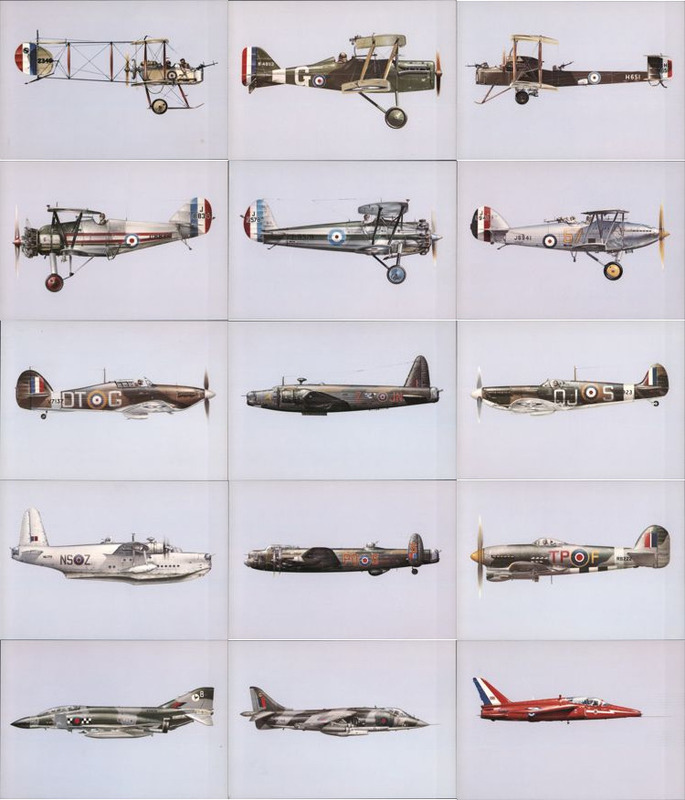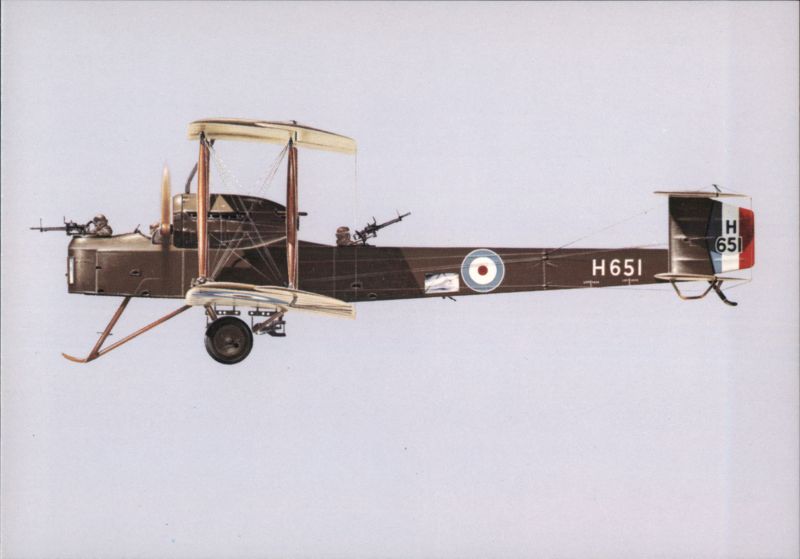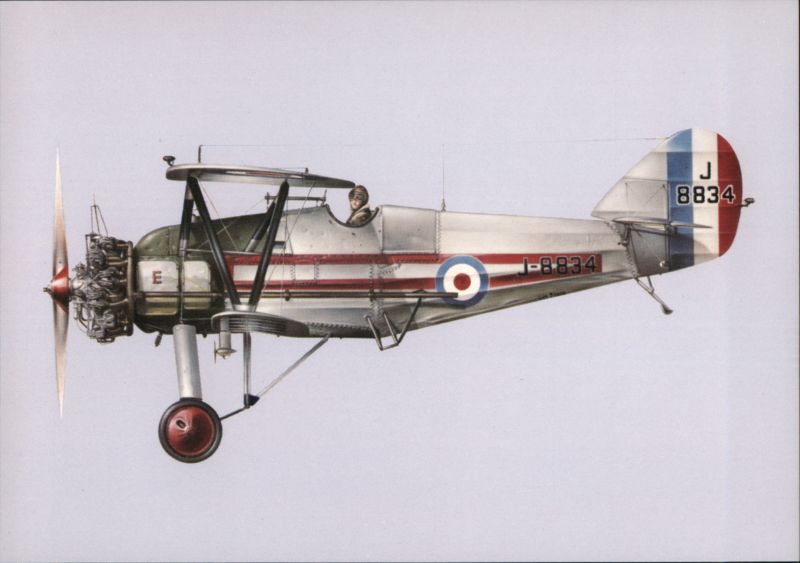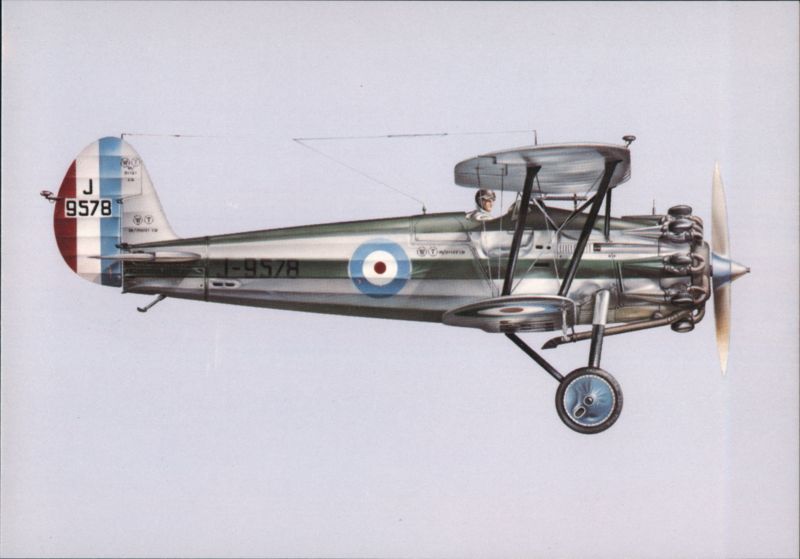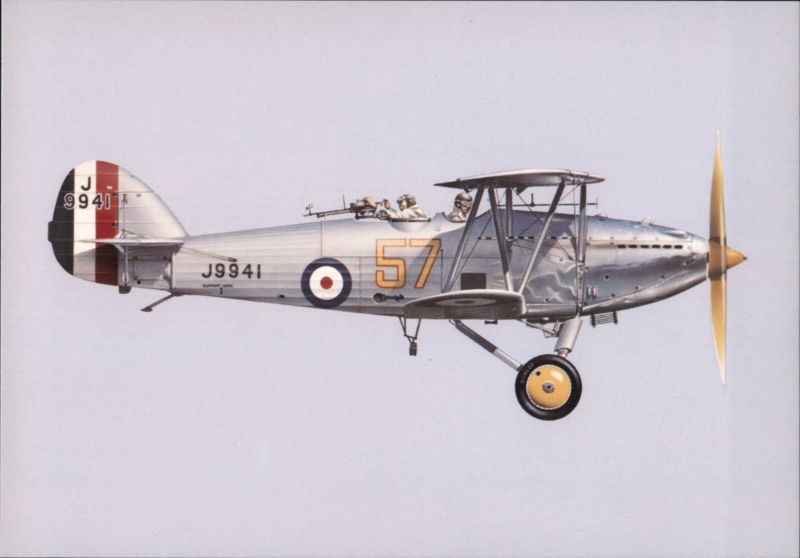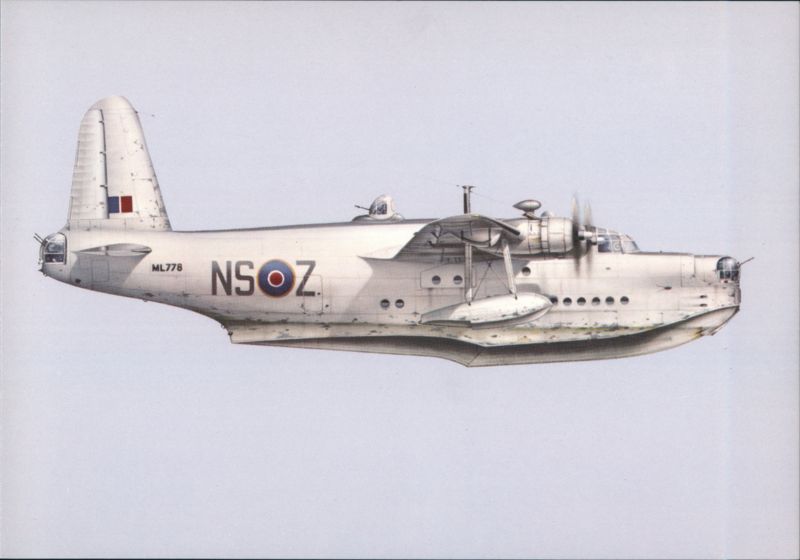Set of 15: Aeroplanes of the Royal Naval Air Service and Royal Flying Corps
Front:
2345
BOMBAY
(2)
B4863
Go
TO
12
651
H651
J-8834
8834
9578
******
WT
-9578
(WT) anarc
9940
J9941
V7137
DTOC
ON
BUCCA
EAST INDIA
SQUADRON
JOS
R6923
อ
ML778
NSOZ
POOS
TPOF
RB222
F
XV574
B
XW768
XSIOZ
Back:
No. 4
VICKERS FB5 No. 5 Sqn. RFC
To the Vickers FB5 belongs the distinction of being the aircraft that
equipped the first unit of any air force in the world to be created as a
fighter squadron: No. 11 Squadron of the Royal Flying Corps,
which went to France on 25th July, 1915. Other Vickers FB5s had
earlier formed part of the equipment of RFC Squadrons Nos. 2, 5, 7
and 16; No. 18 Squadron was later fully equipped with the type,
and a few were used by the Royal Naval Air Service at Dunkerque.
The FB5 was designed before the war, and its specific purpose of
carrying a machine-gun soon earned it the unofficial nickname of
Vickers Gun Bus. It remained in operational use until the Spring of
1916. A somewhat refined development of the FB5 was produced
as the FB9, but few aircraft of the later type saw operational use.
Most FB5s and FB9s ended their service at training units.
Aeroplanes of the Royal Naval Air Service, Royal Flying Corps and Royal Air Force
No. 12
No. 56 Sqn. RFC
SE5a
The SE5a was considered by many pilots to be the best British
single-seat fighter of the 1914-18 war. The first production aircraft
had the 150 hp Hispano-Suiza, were designated SE5, and were first
flown operationally in April, 1917 by No. 56 Squadron RFC. The
later SE5a had the 200 or 220 hp Hispano-Suiza or 200 hp Wolseley
Viper engine.
In France, Palestine, Macedonia and Mesopotamia the SE5a gave
outstanding service with squadrons of the RFC, RAF, Australian
Flying Corps and United States Air Service. Large-scale production
in the United States was stopped only by the Armistice.
The SE5a was flown by the leading British fighting pilots,
including Captain W. A. Beauchamp-Proctor, VC, DSO, MC,
DFC; Major W. A. Bishop, VC, DSO, MC, DFC; Major J. T. B.
McCudden, VC, DSO, MC, DFC, MM; and Major E. W.
Mannock, VC, DSO, MC; the earlier SE5 had been flown by
Captain Albert Ball, VC, DSO, MC.
Aeroplanes of the Royal Naval Air Service, Royal Flying Corps and Royal Air Force
No. 17
VICKERS VIMY
RAE FARNBOROUGH
The Vimy was designed in 1917 with range enough to attack Berlin
from bases on the Western Front but the war ended before it could
be used operationally. Subsequently it served with nine RAF units
at home and overseas and with various training squadrons in Britain
and Egypt. It was withdrawn from the bomber role in 1924 but
many were used as training aircraft until the early 1930s.
The Vimy is best remembered for its long-distance flights: in June,
1919 the first non-stop crossing of the Atlantic by Captain John
Alcock and Lieutenant Arthur Whitten Brown; in November, 1919
the first flight from Britain to Australia by Captain Ross Smith and
Lieutenant Keith Smith.
Aeroplanes of the Royal Naval Air Service, Royal Flying Corps and Royal Air Force
No. 18
ARMSTRONG WHITWORTH SISKIN MK IIIA
No. 1 Sqn. RAF
Two versions of the Siskin were used by RAF squadrons: the Siskin
III, of composite wood-and-metal construction, which equipped
fighter squadrons Nos. 41 and 111; and the all-metal Siskin IIIA,
which entered service in 1927 and was used by Squadrons Nos. 1,
17, 19, 25, 29, 32, 41, 43, 56 and 111.
As a means of providing work for the British aircraft industry in the
inter-war years, production orders for the Siskin IIIA were given to
the Gloster, Bristol and Blackburn companies in addition to the
Armstrong Whitworth firm. More than 350 were built between 1926
and 1931.
Despite its heavy appearance the Siskin was a highly
manoeuverable aircraft and was a regular performer in aerobatic
items at Hendon Air Displays. A dual-control two-seat version saw
limited service as a trainer, and a few Siskins were used by the
Royal Canadian Air Force.
Aeroplanes of the Royal Naval Air Service, Royal Flying Corps and Royal Air Force
No. 24
BRISTOL BULLDOG MK II No. 3 Sqn. RAF
One of the classic single-seat fighters of the inter-war period, the
Bulldog was designed by Captain F. S. Barnwell, who had also
created the superb Bristol F2B fighter of 1917-18.
The first aircraft to enter RAF service were Bulldog Mk Ils, which
replaced the Hawker Woodcocks of Squadrons Nos. 3 and 17 in
1929. Later deliveries were of the more numerous Bulldog IIA,
which ultimately equipped ten of the thirteen fighter squadrons that
constituted the Air Defence of Great Britain in the 1930s.
The Bulldog was immensely popular in the RAF and its excellence is
reflected in the fact that it was also used by the air forces of
Sweden, Estonia, Latvia, Denmark, Finland, and by the Royal
Australian Air Force. It remained a front-line fighter with the RAF
until 1937. A two-seat trainer version was built in some numbers for
the RAF.
Aeroplanes of the Royal Naval Air Service, Royal Flying Corps and Royal Air Force
No. 25
HAWKER HART No. 57 Sqn. RAF
First flown in 1928, the Hawker Hart day bomber was one of the
finest military aircraft of its time, having a performance superior to
that of any fighter aircraft in existence or on order, with the
exception of its almost contemporary stablemate, the Hawker Fury.
The Hart was ordered for the RAF and was first supplied to No. 33
Squadron in January, 1930. The Hart itself subsequently equipped
Squadrons Nos. 6, 11, 12, 15, 18, 24, 39, 40, 57, 60 and 142, and
the Royal Auxiliary Air Force Squadrons Nos. 500, 501, 503, 600,
601, 602, 603, 605, 609, 610 and 611. Versions of the Hart were
supplied to many overseas air forces.
From the basic Hart design were developed the Audax, Demon,
Hardy, Osprey, Hind and Hector, all of which were supplied to the
RAF in large numbers for widely varying duties, and the Hartbees,
built for the South African Air Force. Some of these later variants
saw limited operational use in the 1939-45 war.
Fra
Aeroplanes of the Royal Naval Air Service, Royal Flying Corps and Royal Air Force
HAWKER HURRICANE MK I No. 257 Sqn. RAF
The first fighter aircraft in the world to have eight machine-guns,
the Hurricane went into production in 1936. First deliveries were
made to No. 111 Squadron late in 1937, and by September, 1939
the RAF had nineteen Hurricane squadrons.
The Hurricane was astonishingly versatile and rugged. Its
armament was progressively increased and augmented by bombs
or rockets. The Mk IID, armed with two 40 mm Vickers or Rolls-
Royce guns, was used with shattering effect as an anti-tank
weapon.
Best remembered for its heroic part in the Battle of Britain, the
Hurricane in 1940 shot down more enemy aircraft than all other
home defence elements combined. It fought in France, Russia (over
2,900 were sent to the Russian Air Force), North Africa and Burma,
and, in its Sea Hurricane form, operated from aircraft carriers and
was carried on catapults aboard merchant ships.
No. 34
Aeroplanes of the Royal Naval Air Service, Royal Flying Corps and Royal Air Force
No. 37
VICKERS WELLINGTON MK III No. 150 Sqn. RAF
The Wellington served the RAF in many roles from the time of its
introduction into the Service in October, 1938 through the entire
war period and on until 1953, when the last Wellington T10 trainer
was withdrawn. Distinguished from its contemporaries by the
ingenious geodetic form of construction devised by Dr. Barnes
Wallis, the Wellington was the backbone of Bomber Command in
the early years of the 1939-45 war.
Wellington bombers made their last operational flight on the night
of 8th/9th October, 1943, but by then other variants were in service
with Coastal Command, some equipped with Leigh lights and some
armed with rockets. Others, fitted with vast electrically energised
hoops of duralumin, were employed to explode magnetic mines.
Aeroplanes of the Royal Naval Air Service, Royal Flying Corps and Royal Air Force
SUPERMARINE SPITFIRE MK VB No. 92 Sqn. RAF
Possibly the most famous fighter aircraft in history, the Spitfire
combined great beauty of line with excellent flying qualities, high
manoeuverability and heavy armament. The prototype flew some
four months later than its great contemporary, the Hurricane, and
the Spitfire was considerably the faster of the two.
First deliveries of production Spitfires were made to No. 19
Squadron in August, 1938 and by September, 1939 Fighter
Command had nine full squadrons of Spitfires. The design proved
capable of almost infinite variety of employment and development.
In the later Marks the Rolls-Royce Griffon engine replaced the
peerless Merlin, and as power and weight increased the Spitfire's
handling qualities demanded more of pilots.
Not the least of its distinctions was its unique claim to be the only
Allied fighter to remain continuously in production throughout the
1939-45 war.
No. 36
Aeroplanes of the Royal Naval Air Service, Royal Flying Corps and Royal Air Force
No. 40
SHORT SUNDERLAND GRV No. 201 Sqn. RAF
The Sunderland, a military development of the Short Empire civil
flying-boat had been produced in sufficient numbers to equip a few
squadrons by the time war broke out in 1939. With its long-range,
great load-carrying capability and heavy defensive armament, the
Sunderland proved to be a formidable weapon on oversea patrols
and a pugnacious adversary when attacked by enemy aircraft.
It added fresh laurels to its war record by its part in the Berlin airlift,
during which Sunderlands operated from the Havelsee in West
Berlin. Sunderlands again flew operationally throughout the Korean
war and against Malayan terrorists. It was withdrawn from RAF
service in May, 1959. Sunderlands remained in service with the
French Aeronavale until 1960 and with the Royal New Zealand Air
Force until 1967.
Aeroplanes of the Royal Naval Air Service, Royal Flying Corps and Royal Air Force
No. 43
AVRO LANCASTER MK I No. 467 Sqn. RAF
Probably the most famous British heavy bomber of the 1939-45
war, the Lancaster was virtually a four-engine development of the
unsuccessful Avro Manchester. The first prototype flew in January,
1941, and the first squadron to be fully equipped with Lancasters
was No. 44, early in 1942.
The Lancaster had an outstanding performance and excellent flying
characteristics. It was therefore ordered in large numbers, and a
total of 7,377 were delivered. Widely used by Bomber Command
until the war ended, the Lancaster won a place in history as the
aircraft that made the successful attacks on the Mohne and Eder
dams on 16th/17th May, 1943. It was also the only British bomber
capable of carrying the 12,000 lb 'Tallboy' and 22,000 lb 'Grand
Slam' bombs. The last Lancaster in RAF service was withdrawn in
October, 1956.
Aeroplanes of the Royal Naval Air Service, Royal Flying Corps and Royal Air Force
No. 45
HAWKER TYPHOON MK IB
No. 198 Sqn. RAF
The Typhoon, designed from the outset as a 12 gun fighter, was
intended to be the successor to the Hurricane. It suffered many
development troubles, both in the airframe and its complex 24
cylinder Sabre engine; and its climbing performance was
disappointing.
Nevertheless, it was at the time of its introduction in 1941 the
fastest Allied fighter at low level. It was at low levels, especially in
the close-support role, that the Typhoon excelled; and as a tank
destroyer the rocket-armed Typhoon played a decisive part in land
battles.
The ground-attack Typhoons wrought havoc among enemy
communications throughout the final European campaign and
harassed enemy coastal shipping. By the end of the war it was
being replaced by the Tempest, and today only one specimen
survives in the RAF Museum.
Aeroplanes of the Royal Naval Air Service, Royal Flying Corps and Royal Air Force
No. 57
MCDONNELL DOUGLAS PHANTOM FG MK 1
No. 43 Sqn. RAF
The Phantom, developed as a two-seat fighter, has been used in
the Royal Air Force in the air defence and ground attack and tactical
reconnaissance roles. It was designed for the US Navy in 1960 but
did not begin to equip the RAF until 1968 after Rolls Royce Spey
turbofans had replaced the American General Electric engines.
Delivery of 168 Phantoms to the United Kingdom was completed in
October, 1969. With the entry of the Jaguar into service as the
principal tactical ground-attack aircraft, the Phantom reverted to
pure interceptor duties partially replacing the Lightning in Strike
Command.
Aeroplanes of the Royal Naval Air Service, Royal Flying Corps and Royal Air Force
No. 55
HAWKER SIDDELEY HARRIER GR MK 1A No. 3 Sqn. RAF
The Harrier was the first VTOL combat aircraft to enter regular
squadron service with any air force in the world, joining No. 1
Squadron RAF in July, 1969. Developed from the P1127 Kestrel, it
was completely re-engineered to accommodate a more powerful
engine, a sophisticated navigation/attack system, increased
internal fuel capacity and an in-flight refuelling capability.
Based in England and Germany, the Harrier is deployed as a ground
attack and reconnaissance aircraft. It is also used by the United
States Marine Corps.
Aeroplanes of the Royal Naval Air Service, Royal Flying Corps and Royal Air Force
No. 54
HAWKER SIDDELEY GNAT T MK I
ROYAL AIR FORCE AEROBATIC TEAM - THE RED ARROWS
This small high performance aircraft was designed by Follands as a
lightweight fighter and first flew as the Midge in July, 1955. It was
not adopted by the RAF but its potentialities as a two-seat
advanced trainer were fully realized and it entered service as the
Gnat in 1962.
It superseded the Vampire T11 as the RAF's standard advanced
trainer giving the pupil all the high-speed performance of a fighter
whilst providing special low-speed and landing characteristics
required for training.
The Gnat has been the well-known choice of the Red Arrows, the
RAF's aerobatic team, for many years. It will remain in service until
replacement by the Hawk.
Aeroplanes of the Royal Naval Air Service, Royal Flying Corps and Royal Air Force

